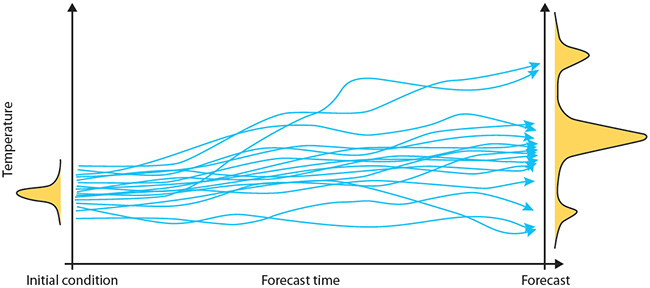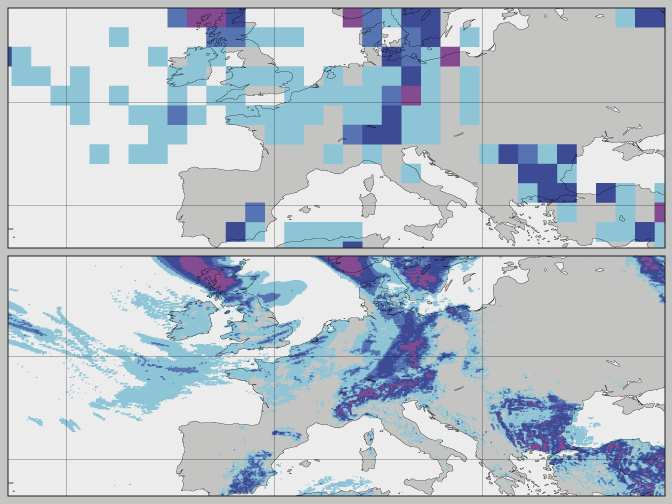

On 24 November 1992, ECMWF started producing probabilistic or 'ensemble' forecasts. Since then, ensemble forecasting at the Centre has been going from strength to strength.
Now a cornerstone of our new ten-year Strategy, it will be the theme of one of our flagship events in 2017, the Annual Seminar (11–14 September).
Registration for the Annual Seminar is now open.
The reason for the growing emphasis on probabilities is simple: weather predictions are inherently uncertain.
This has led users to ask for a confidence estimate for each forecast, for some objective indication of how much they can trust the forecast.
The three main reasons why forecasts are uncertain are the inherent uncertainty in the estimation of the current state of the Earth system; the chaotic nature of atmospheric dynamics; and the sheer complexity of weather-related Earth system processes.
As a result, the initial conditions from which every forecast starts are inevitably slightly inaccurate, and our simulations of Earth system processes are necessarily approximate.

Weather is not just the result of complex atmospheric processes but also of the atmosphere’s interactions with its boundaries, such as the land surface, the oceans and sea ice. Relatively small-scale features such as lakes, vegetation and mountains can have a strong influence on the weather. (Photo: Ingram Publishing/Thinkstock)
Of course, we can always give it our best shot and produce a ‘deterministic’ forecast.
We might for example predict that the minimum temperature in Prague in a week’s time is going to be -3°C. But we can’t be certain that it will turn out that way, and we never will be. We can only hope that the prediction has a high degree of certainty.
Ensemble forecasts enable us to assess just how sure we can be: they describe the range of possible scenarios and their likelihood of occurrence.
How does it work?
Not one forecast but many
The basic idea is to produce not just one forecast but an ensemble of forecasts.
Each forecast is produced starting from slightly different initial conditions to account for imperfections in our assessment of the current state of the Earth system, and with slightly perturbed models to account for approximations in the way we simulate Earth system processes.

An ensemble of forecasts produces a range of possible scenarios rather than a single predicted value. The distribution of the ensemble members gives an indication of the likelihood of occurrence of those scenarios.
At ECMWF every ensemble forecast comprises 51 such individual forecasts, or ensemble members.
The spread between the ensemble members provides vital information on the degree of confidence we can have in our predictions. It is the first and easiest way to estimate it.
A narrow spread suggests that predictability is high and that the outcome is likely to fall within a narrow band of possible values.
A broad spread suggests that predictability is low and that a relatively broad range of outcomes is possible.
In either case, the forecast we might end up with for Prague would look rather different. It might for example say that there is a 70% chance that the minimum temperature in Prague in a week’s time will be below -3°C, and a 20% chance that it will plummet to below -6°C.

Ensemble forecasts can be visualised by box-and-whisker plots. This ten-day forecast for total precipitation in Rome starting at 00 UTC on 6 February 2017 shows high probabilities of more than 1 mm falling in the first three six-hour intervals. Subsequently the picture is mixed, with a few days likely to be dry but also some ensemble members predicting amounts of up to 24 mm in a six-hour interval towards the end of the period. The plots show the median (short horizontal line), the 25th and 75th percentile (wide vertical box), the 10th and 90th percentiles (narrower boxes) and the minimum and maximum predicted values (vertical lines).
How probabilities can aid decision-making
At first sight probabilistic forecasts might look difficult to use because they don’t tell us anything for sure.
In reality, they provide us with a more complete, reliable and accurate view of what might happen in the future. They thus bring definite benefits for decision-making.
Ideally a well-calibrated probabilistic forecast (i.e. a reliable one) provides reliable information on the relative frequency of an event occurring.
If it says that there is an 80% chance of maximum temperatures rising above a certain threshold, then in 80% of cases when such a forecast is made temperatures should indeed rise above that threshold.
Forecast users can exploit such information for rational decision-making, for example when they weigh the losses associated with adverse weather events against the cost of taking precautionary action.

These charts illustrate differences in the potential economic value of ECMWF’s ensemble forecasts (ENS) and deterministic high-resolution forecasts (HRES) for predictions that 24-hour precipitation amounts will exceed 5 mm over Europe in the summer of 2014 (June to August), for different cost/loss ratios at which precautionary action is taken. The article ‘Decisions, decisions…!’ in ECMWF Newsletter No. 141 (PDF) explains in more detail how ensemble forecasts can support decision-making.
The future of ensemble forecasting
The title of this year’s Annual Seminar is ‘Ensemble Prediction: Past, Present and Future’.
The future certainly holds the prospect of some exciting developments.
The horizontal grid spacing of ECMWF’s global ensemble forecasts is currently 18 km. The Centre’s new Strategy says that by 2025 it should have come down to 5 km. This will require multiple forecasts to be produced at a resolution nearly twice as high as the Centre’s current high-resolution forecast.
“It is at the limit both in terms of what we can do scientifically and in terms of the computing capacity we envisage having in 2025,” Director of Research Erland Källén said last year after the Strategy was approved.

The horizontal resolution of ECMWF’s weather forecasts has increased hugely over the last few decades, from 210 km (top) to 9 km in the current high-resolution forecast (bottom). The planned move to 5 km ensemble forecasts by 2025 is another big step.
The current ensemble uses a coupled ocean, sea ice, land and atmosphere model. The Centre’s new Strategy envisages including additional relevant Earth-system processes in the ensemble, to be able to extend the forecast skill horizon further. Work has started to look into the potential benefits of including interactive aerosols and ozone, and of improving the simulation of stratospheric processes.
Discussions during the Annual Seminar will centre on whether existing ensemble designs can continue to deliver improvements or whether we need to reconsider their configurations.
The Seminar will also revisit the main assumptions behind the different strategies used to simulate initial and model uncertainties, and it will look at how global and regional ensembles can complement each other.
Registration closes 27 July 2017.
